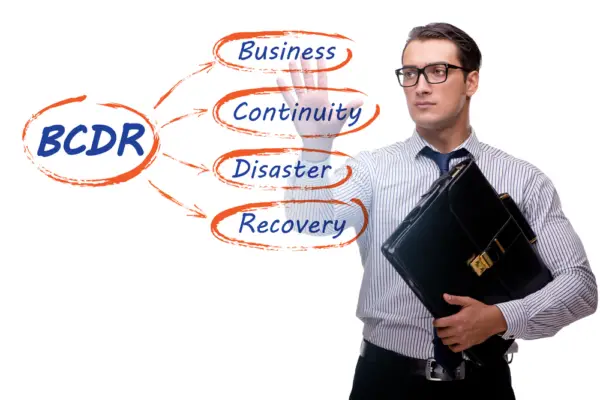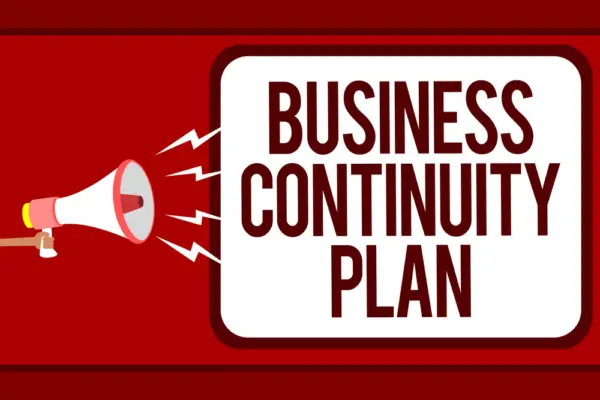Business Continuity Planning (BCP) typically involves several phases to ensure an organization can continue operations before, during, and after a disruptive event. While there may be some variations in how these phases are named and structured, they generally include:
- Initiation: This phase involves establishing the need for a business continuity plan, securing management support, and defining the project scope and objectives.
- Business Impact Analysis (BIA): During this phase, the organization identifies critical business functions, assesses the risks to these functions, and determines the potential impact of different types of business disruption. The goal is to understand which areas are most at risk and could cause the most significant harm to the business if they were not operational.
- Strategy Development: In this phase, the organization develops strategies to manage the risks identified in the BIA. This includes determining how to maintain critical operations at an acceptable level following a disruption.
- Plan Development: This phase involves the creation of the business continuity plan itself, which includes response procedures for managing an actual disruption. It details the steps to maintain or quickly resume critical operations during an incident.
- Testing and Maintenance: The final phase includes regular testing to ensure the plan works as intended and updating the plan as necessary when there are changes in the business environment or organizational structure.
These phases of BCP help an organization create a robust strategy to deal with potential threats and minimize downtime and financial loss in the event of a disruption.

Business continuity planning is crucial for organizations to ensure their ability to respond and recover from unexpected disruptions. The phases involved in this planning include:
- Risk assessment.
- Strategy development.
- Plan implementation.
- Testing and evaluation.
- Maintenance and review.
Each phase plays a vital role in preparing for potential crises and minimizing the impact on business operations.
Organizations can enhance their resilience and safeguard their future by understanding these phases and their significance.
But what are the key considerations during each phase? And how can organizations ensure an effective and comprehensive approach to business continuity planning?
Let’s explore further.
Key Takeaways
- The risk assessment phase helps identify potential threats and determine recovery time objectives.
- The strategy development phase involves setting goals, analyzing business impacts, and developing recovery strategies.
- Resource allocation strategies prioritize critical business functions and determine necessary equipment and supplies.
- Plan implementation involves executing strategies, testing plans through drills, and refining plans based on simulations.
Risk Assessment
Risk assessment is an integral part of business continuity planning. It involves identifying potential threats that could disrupt operations and analyzing the likelihood of their impact.
Identify Potential Threats
During the initial phase of business continuity planning, organizations begin by conducting a comprehensive assessment to identify potential threats and vulnerabilities that could impact their operations.
This risk assessment is crucial as it helps the organization understand the potential risks and allows them to prioritize resources and develop effective response procedures.
Key areas of focus during this phase include identifying risks related to natural disasters, evaluating the impact on employees and customers, and assessing the availability of necessary resources.
Analyze Impact Likelihood
To effectively assess the potential impact of identified threats, organizations must conduct an in-depth analysis of the likelihood of these risks occurring.
This can be achieved through a comprehensive risk assessment process, which involves evaluating the probability of various potential hazards and their potential impacts on critical business functions and processes.
The analysis helps organizations determine the recovery time objective and identify necessary mitigations to minimize the effect on essential functions. Action can then be taken to strengthen the organization’s resilience and ensure business continuity.
| Risk Assessment | Potential Impacts | Mitigations |
|---|---|---|
| Identify potential risks | Assess the impact on critical functions | Implement measures to reduce risks |
| Analyze likelihood of risks | Determine the recovery time objective | Develop strategies for business continuity |
| Identify necessary mitigations | Minimize impact on critical business processes | Implement the necessary safeguards |
Strategy Development
Several vital points need to be addressed in the strategy development phase in business continuity planning.
Firstly, the goal-setting process is crucial in determining what the organization aims to achieve regarding resilience and recovery.
Secondly, risk assessment methods are vital in identifying potential threats and vulnerabilities that could impact the organization.
Goal Setting Process
The initial phase of business continuity planning involves developing a strategic goal-setting process. This process is crucial in aligning the business continuity planning process with the overall goals and objectives of the organization.
It includes conducting a business impact analysis and risk assessment to identify critical business functions and potential risks. Based on these findings, recovery strategies are developed, and key performance indicators are established.
Additionally, a communication plan and testing and maintenance procedures are implemented to ensure the effectiveness of the business continuity plan.
Risk Assessment Methods
Various methods can be employed to conduct a risk assessment as part of the strategy development phase in business continuity planning.
These methods include impact assessment, business impact analysis, risk analysis, disruption analysis, risk identification, risk mitigation, and risk evaluation.
A risk assessment aims to identify potential risks and vulnerabilities that could impact critical business functions. Organizations can minimize disruptions and ensure business continuity by conducting thorough risk assessments and implementing effective risk management strategies.
| Method | Description |
|---|---|
| Impact Assessment | Evaluates the potential consequences and severity of risks. |
| Risk Analysis | Examines the likelihood and potential impact of identified risks. |
| Disruption Analysis | Analyzes the potential disruptions that could occur in critical business functions. |
Resource Allocation Strategies
To effectively develop resource allocation strategies for business continuity planning, organizations must carefully analyze their critical business functions and prioritize the allocation of resources based on their importance and potential impact on overall business continuity.
This involves considering the criticalness factor of each business function and determining the necessary equipment, supplies, and technology systems required to sustain those functions during a crisis.
The resource allocation strategies should ensure the uninterrupted operation of the most critical business functions.
Plan Implementation
The implementation phase of business continuity planning involves executing strategies, allocating resources, and testing and refining the plan.
Execution strategies involve implementing the plan and following the established procedures and protocols.
Resource allocation ensures that the necessary personnel, technology, and materials are available to support the plan.
Testing and refining the plan allows for identifying and addressing any weaknesses or areas for improvement, ensuring its effectiveness in a real-life scenario.
Execution Strategies
Implementing a practical plan for business continuity requires careful execution strategies to ensure smooth and efficient implementation.
Business continuity professionals understand the importance of conducting exercises and drills to test the plan’s effectiveness in responding to disruptive events.
These exercises help identify gaps in the emergency response, supply chain, and potential business impacts. Organizations can refine their plans by simulating a disruption and enhancing their ability to mitigate risks.
Resource Allocation
During the implementation phase of business continuity planning, careful allocation of resources is crucial to ensure the smooth execution of the plan.
Resource allocation involves determining the necessary resources, such as finances, workforce, and technology, to implement the disaster recovery plan effectively.
This includes identifying critical business operations, assessing key risks, and developing a backup plan to mitigate the disruption of business functions.
Effective communication with employees is also essential to prevent and minimize business disruptions.
Testing and Refining
Thorough testing and refinement are essential during the implementation phase to ensure the effectiveness of the business continuity plan.
This proactive approach allows organizations to identify weaknesses or gaps in their strategy and make necessary adjustments.
Testing methods such as tabletop exercises and simulation testing help evaluate the response strategy in a controlled environment. Refining action plans based on testing helps businesses prepare for potential interruptions.
Testing and Evaluation
The testing and evaluation phase of business continuity planning involves two key points: test frequency and evaluation metrics.
Test frequency refers to the frequency at which tests are conducted to ensure the effectiveness of the business continuity plan.
Evaluation metrics are the criteria used to assess the success and performance of the plan during testing.
Both these points are crucial in determining the readiness and reliability of the plan in the event of a disruption.

Test Frequency
Test frequency is critical to the testing and evaluation phase in business continuity planning. It determines how often tests are conducted to assess the plan’s effectiveness in a disaster or unexpected event.
The frequency of these tests should be determined based on the organization’s risk tolerance, the complexity of its services and technology, and the involvement of senior management and business partners. Regular testing helps identify weaknesses and minimize potential losses.
Evaluation Metrics
Evaluation metrics are crucial in assessing the effectiveness of business continuity plans during the testing and evaluation phase.
These metrics help measure the performance of various components of the business continuity management process, such as the incident response plan, risk analysis and impact assessment, and alternate resources.
Organizations can use metrics to identify improvement areas and ensure robust plans for critical events. One way to visualize the importance of evaluation metrics is through the following table:
| Evaluation Metric | Description | Purpose |
|---|---|---|
| Business Continuity Impact Analysis | Assess the potential impact of disruptive incidents on business operations | Identify critical processes and prioritize recovery efforts |
| Supply Chain Disruption | Measure the impact of disruptions in the supply chain | Identify vulnerabilities and implement contingency plans |
| Test Frequency | Determine how often business continuity plans are tested | Ensure plans are up-to-date and effective |
| Incident Response Plan | Evaluate the effectiveness of the plan in responding to incidents | Identify gaps and improve response capabilities |
| Alternate Resources | Assess the availability and adequacy of alternate resources | Ensure continuity of operations during disruptions |
Maintenance and Review
Maintenance and review are crucial aspects of business continuity planning. Regular audits for compliance ensure that the plan is current and aligns with industry standards.
Additionally, continual improvement strategies help identify areas of weakness and allow for necessary adjustments to enhance the plan’s effectiveness.
Regular Audits for Compliance
Regular audits for compliance are an essential component of business continuity planning. They ensure that all necessary measures are in place and adhered to.
These audits help organizations identify gaps or weaknesses in their processes and systems, allowing them to take corrective actions promptly.
Regular audits also demonstrate a commitment to following regulations and industry standards. They provide an opportunity to assess the effectiveness of the business continuity plan and make necessary improvements.
Continual Improvement Strategies
Organizations implement continual improvement strategies through regular maintenance and review processes to ensure business continuity plans‘ ongoing effectiveness and relevance.
These strategies are integral to the business continuity management lifecycle and the business continuity management system.
Frequently Asked Questions
What Are the Key Elements to Consider During the Risk Assessment Phase of Business Continuity Planning?
During the risk assessment phase of business continuity planning, key elements include identifying potential threats, assessing their likelihood and impact, evaluating vulnerabilities, and determining the criticality of business functions and resources.
How Can Organizations Effectively Develop a Strategy for Business Continuity Planning?
Organizations can effectively develop a strategy for business continuity planning by thoroughly analyzing potential risks and vulnerabilities, establishing clear objectives and priorities, and implementing comprehensive plans that address all critical business areas.
What Steps Should Be Taken During the Plan Implementation Phase of Business Continuity Planning?
During the plan implementation phase of business continuity planning, organizations should focus on executing the strategies and measures outlined in the plan.
This includes activating emergency response protocols, ensuring effective communication, and regularly testing and updating the plan.
How Can Companies Ensure Their Business Continuity Plans Are Adequately Tested and Evaluated?
Companies can ensure that their business continuity plans are adequately tested and evaluated by implementing a comprehensive testing and evaluation process that includes conducting regular drills and exercises, analyzing the results, and making necessary updates and improvements.
What Is the Importance of Regularly Maintaining and Reviewing Business Continuity Plans?
Maintaining and reviewing business continuity plans ensures their effectiveness and relevance in addressing potential disruptions. It allows organizations to identify gaps, update strategies, and enhance preparedness, ultimately minimizing the impact of disruptions and ensuring business resilience.

Conclusion
Business continuity planning requires several phases, including risk assessment, strategy development, plan implementation, testing and evaluation, and maintenance and review.
Businesses can ensure continuity of operations by enhancing preparedness and resilience, even in the face of unexpected events.
It is essential for organizations to regularly review and update their business continuity plans to adapt to evolving risks and maintain their readiness.

Chris Ekai is a Risk Management expert with over 10 years of experience in the field. He has a Master’s(MSc) degree in Risk Management from University of Portsmouth and is a CPA and Finance professional. He currently works as a Content Manager at Risk Publishing, writing about Enterprise Risk Management, Business Continuity Management and Project Management.

